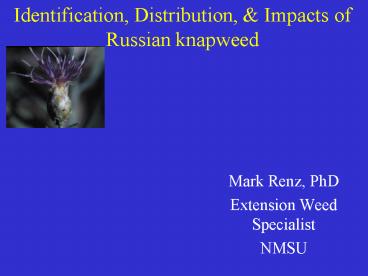Identification, Distribution, - PowerPoint PPT Presentation
1 / 15
Title:
Identification, Distribution,
Description:
Upper leaves are smaller and less lobed with smooth margins. ... CLASSICAL: Subanguina picridis, Stem/leaf gall nematode. Several others being researched ... – PowerPoint PPT presentation
Number of Views:28
Avg rating:3.0/5.0
Title: Identification, Distribution,
1
Identification, Distribution, Impacts of
Russian knapweed
- Mark Renz, PhD
- Extension Weed Specialist
- NMSU
2
Adventitious buds sprouting on roots.
3
Russian Knapweed
- Identification
- Lower Leaves are 2 to 4 inches long and deeply
lobed. - Upper leaves are smaller and less lobed with
smooth margins. - Flower heads occur on shoot tips, and are
urn-shaped generally 1/4 to 1/2 inch in diameter
with smooth papery bracts. - Flower color can ranges from pink to lavender or
white - Roots are perennial, creeping, and have a
distinct black scaly appearance.
4
Rounded and papery bracts.
5
Note Black and scaly deep penetrating roots.
6
Plant habit
- Stems erect 1-2 ft in height
- Lower Leaves lobed
- Upper leaves are smaller and less
- lobed with smooth margins
7
Impacts
- Extremely competitive plant
- As infestations develop they displace nearly all
herbaceous resident vegetation - Reduces forage for livestock
- Can nearly eliminate plant biodiversity
- Produce allelopathic chemicals that inhibit
growth of other plants - Compounds can hamper revegetation efforts
- Poisonous to horses
- Causes chewing disease, a neurological
disorder that produces brain lesion and ulcers in
the mouth - Generally avoided by grazing animals due to
bitter taste
8
Distribution
- Native to southern Asia
- (Mongolia, Iran, Armenia, Turkestan)
- Introduced in infested alfalfa seeds 1890s
- Can find it in 412 counties in 21 western states
- First documented in 1943 in Quay County
9
Russian Knapweed
- Shoot biology
- Root biology
- Reproductive biology
- Management options
10
Shoot biology
- Shoots emerge in early spring from root buds
- Can form dense stands 100-300 shoots/m2
- Shoots densities as low as 11/m2 have
significantly reduced yields in crops - Infestations can persist for gt100 years
- Can survive in low light areas (under tree canopy
in riparian areas) - increased leaf area
11
Root biology
- The main method of spread for Russian knapweed is
from adventitious buds and the creeping perennial
root system. - Roots can grow 6 to 8 feet in one season, and
expand radially up to 14 yd2 in two seasons.
12
Seed biology
- Russian knapweed is not a prolific seed producer.
- Each shoot can produce 50 to 500 seeds
- Seeds remain viable in the soil for 2 to 3 years
(Beck 2003).
13
Russian Knapweed management
- Prevention, early detection and eradication are
the best management tools, as large infestations
are difficult to eliminate. - Small establishing infestations require few
resources to eradicate and typically resident
plants recover from management methods
eliminating the need to restore the site. - The best management plan includes cultural
control combined with mechanical and/or chemical
control techniques. - A single control strategy, such as mowing or
herbicide use, is not sufficient to control old,
dense infestations.
14
Common management tools
- Mechanical
- Mowing, disking can have some success if
integrate with other methods - Biological
- CLASSICAL Subanguina picridis, Stem/leaf gall
nematode. Several others being researched - COMPETITION Healthy, competitive plant community
- Herbicides
- Can be effective and economical for large
infestations - Need to replace open space created
15
Herbicide Active Ingredient Rate of Herbicide Timing of application Comments
Tordon 22K Picloram 1-2 qts/A Anytime plants are actively growing best results in the fall after frost Residual herbicide Selective, will not harm many grass species
Tordon 22K 2,4-D1 Picloram 2,4-D 11.5 qt/A 0.5 lbs ai/A Anytime plants are actively growing best results in the fall after frost Residual herbicide Selective, will not harm many grass species
Reclaim 2,4-D1 Clopyralid 2,4-D 1.0 pt/A 0.5 lbs ai/A Anytime plants are actively growing best results in the fall before frost Residual herbicide
Reclaim ( Transline) Clopyralid 0.67-1.33 pts/A Anytime plants are actively growing best results in the fall before frost Residual herbicide
Plateau methylated seed oil Imazapic methylated seed oil 12 fl oz/A 1 qt/A Late fall after frost Residual herbicide
Arsenal Imazapyr 2 pts/A Anytime plants are actively growing best results in the fall after frost Residual herbicide
Many compounds Glyphosate 3-4 qts/A Flowerbud stage Poor control can result some years
Escort Metsulfuron 0.75 1.0 oz/A Flowerbud stage Residual herbicide Selective, will not harm many grass species
Telar Chlorsulfuron 1.0 2.0 oz/A Flowerbud stage Residual herbicide Selective, will not harm many grass species































